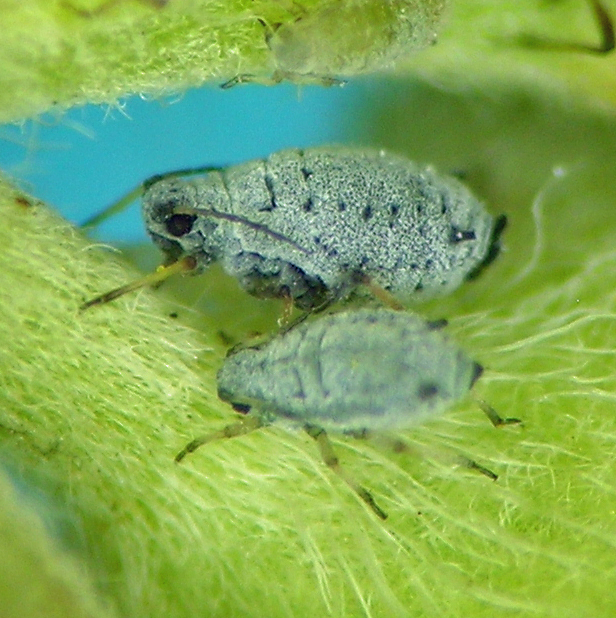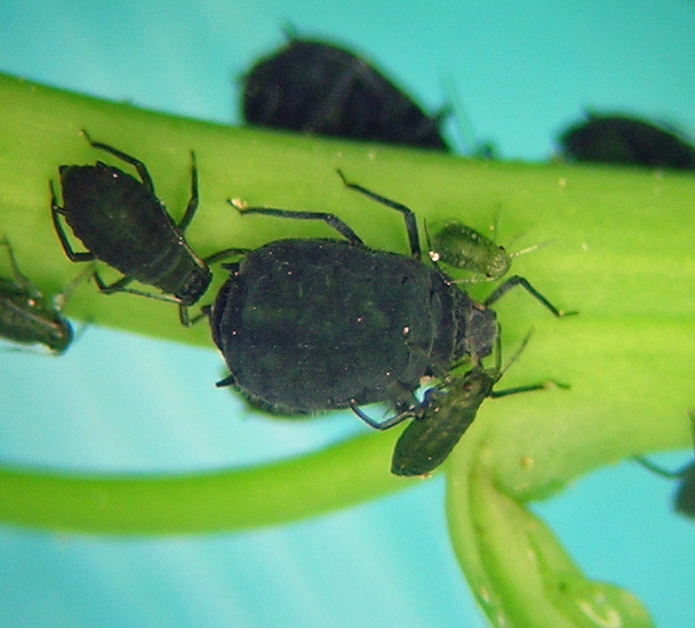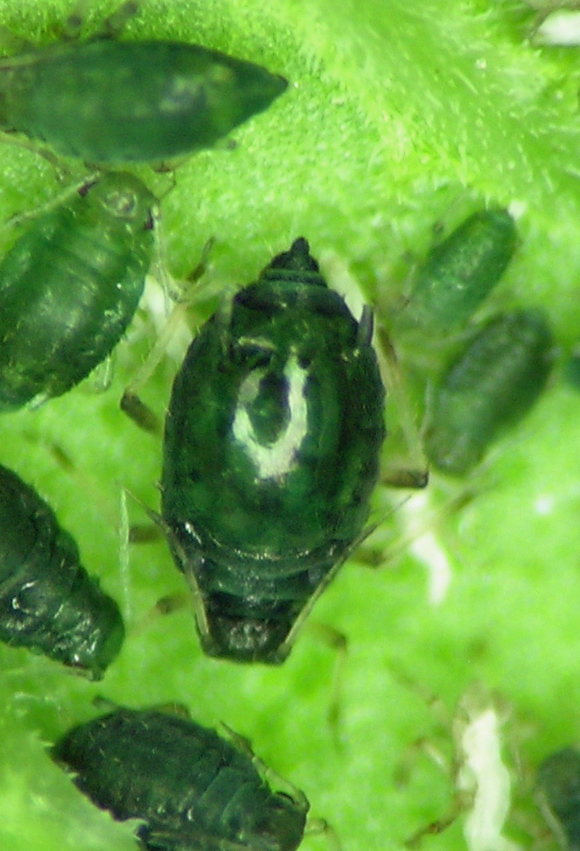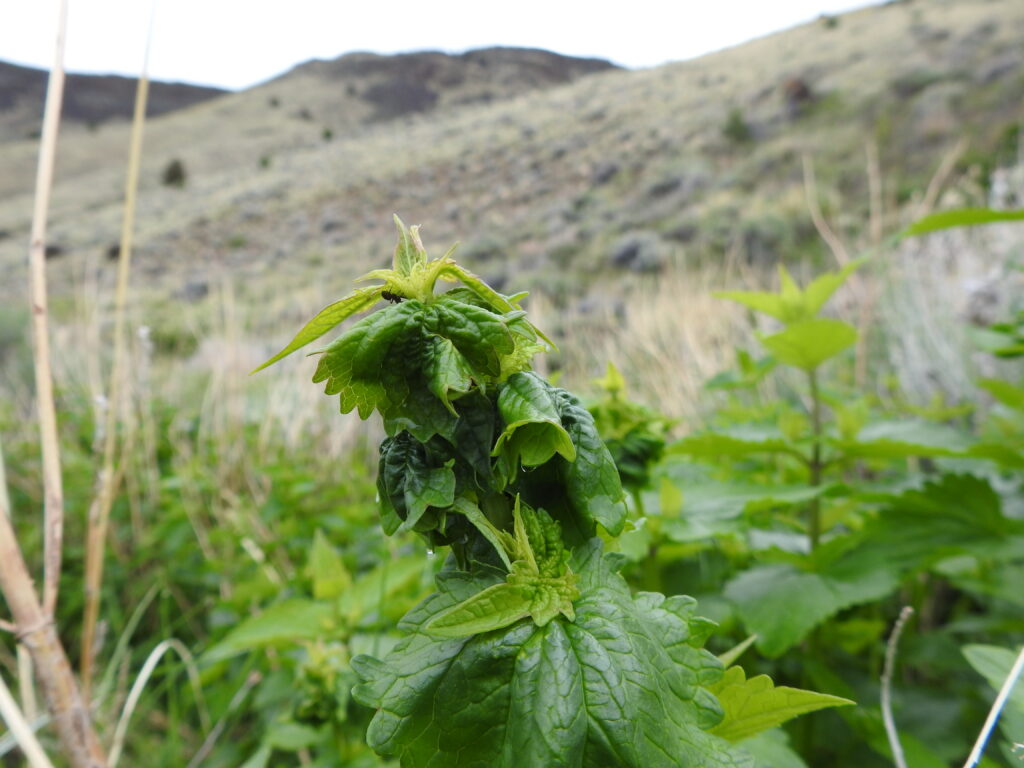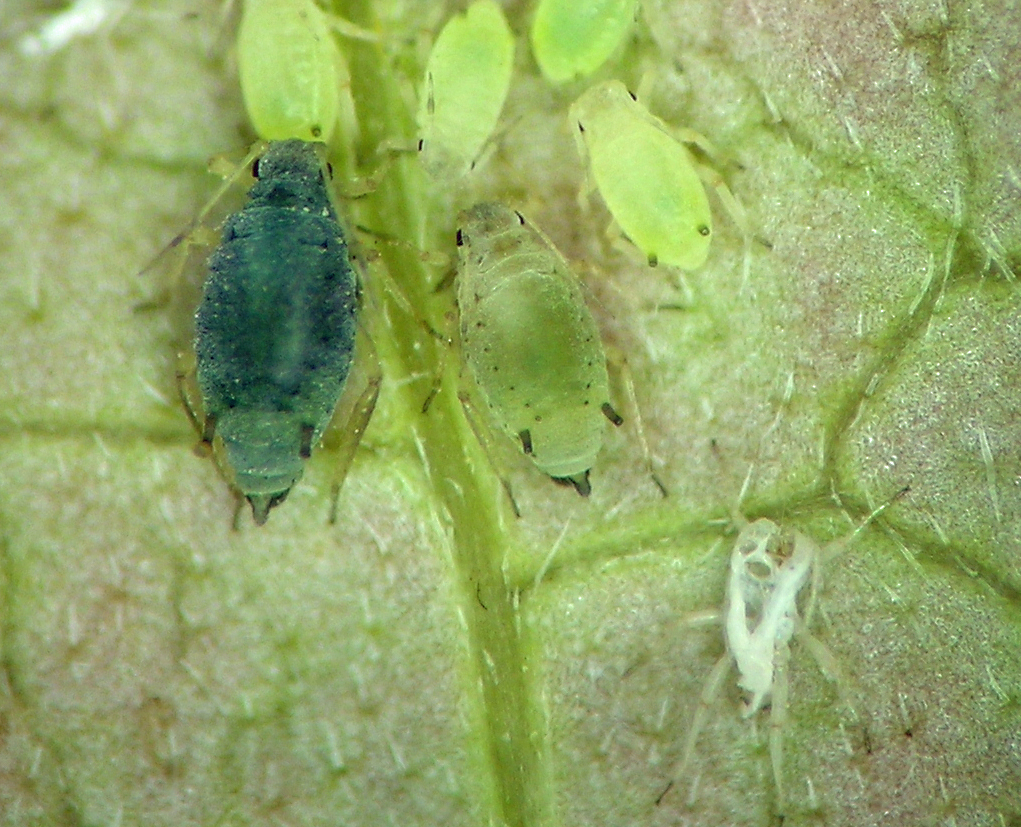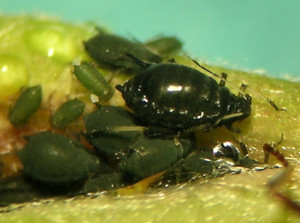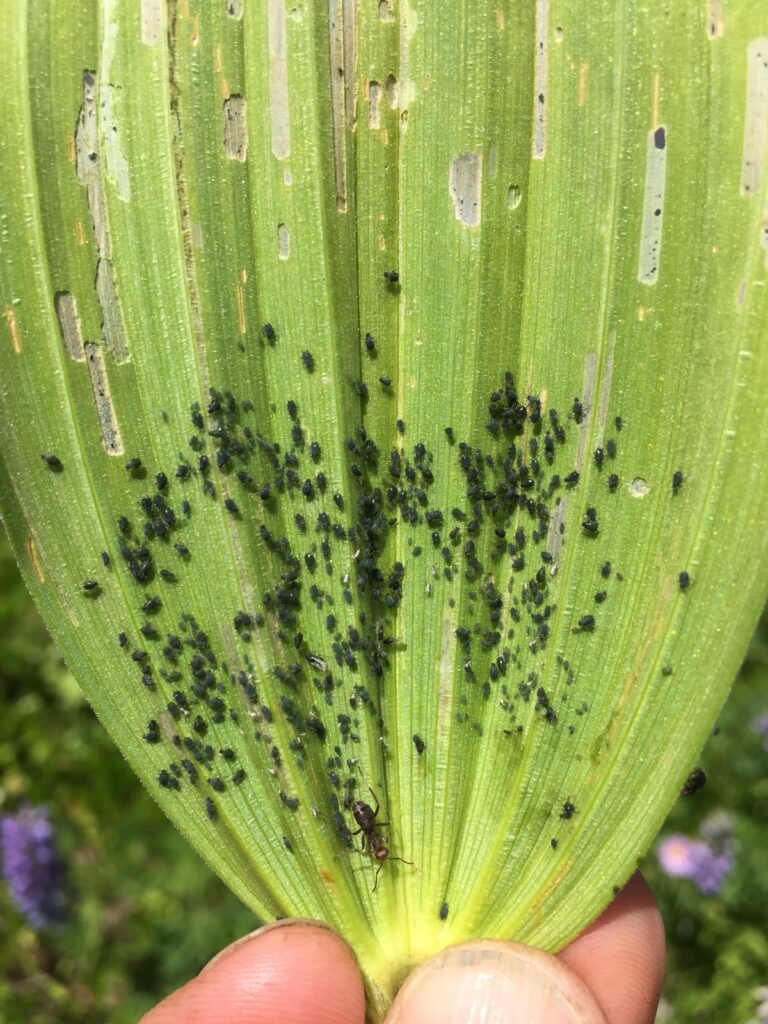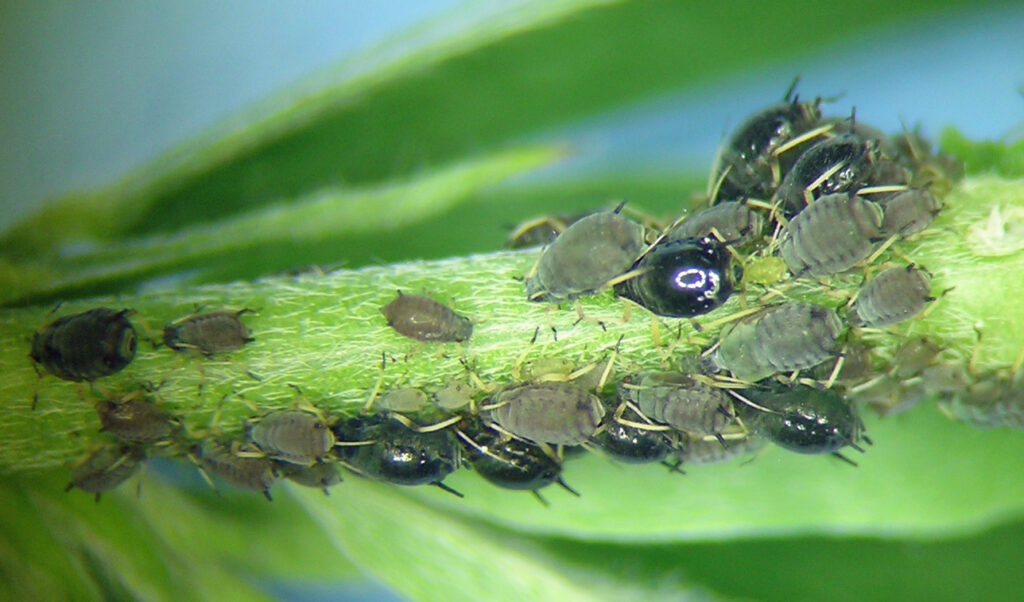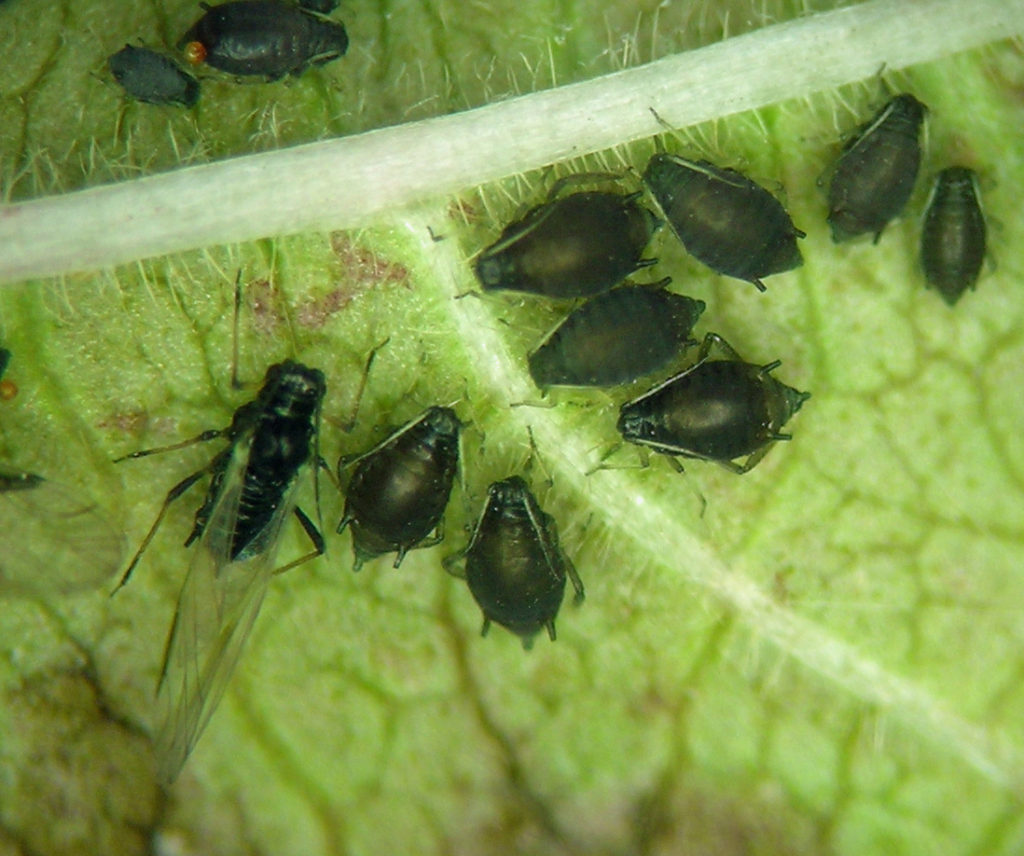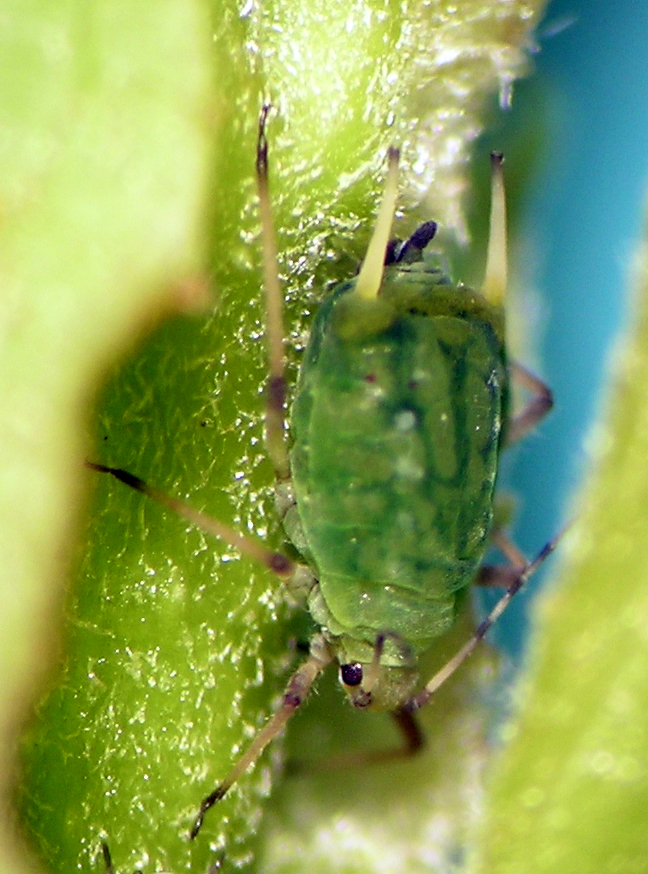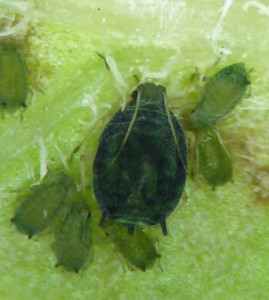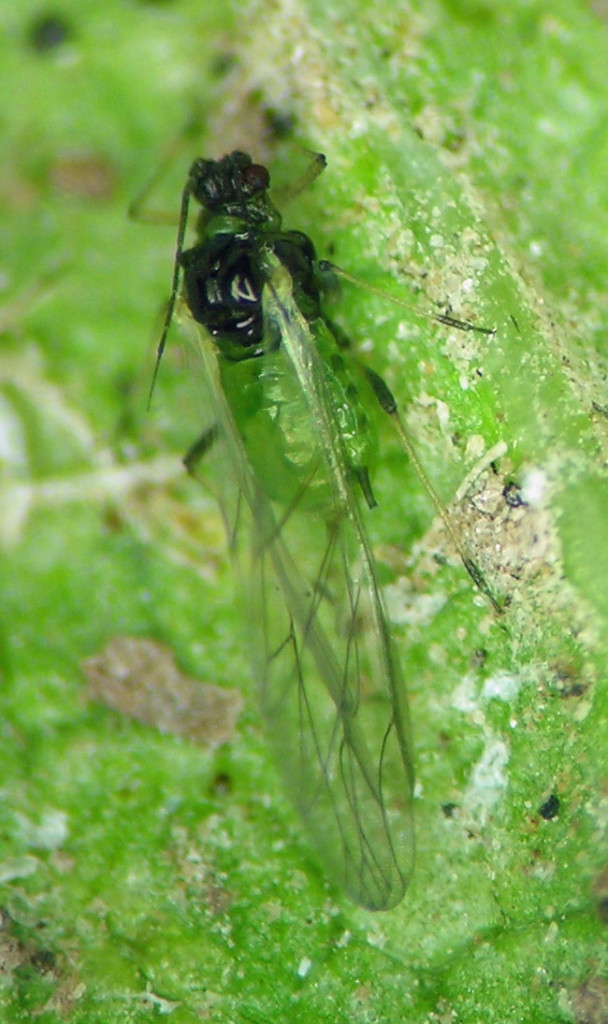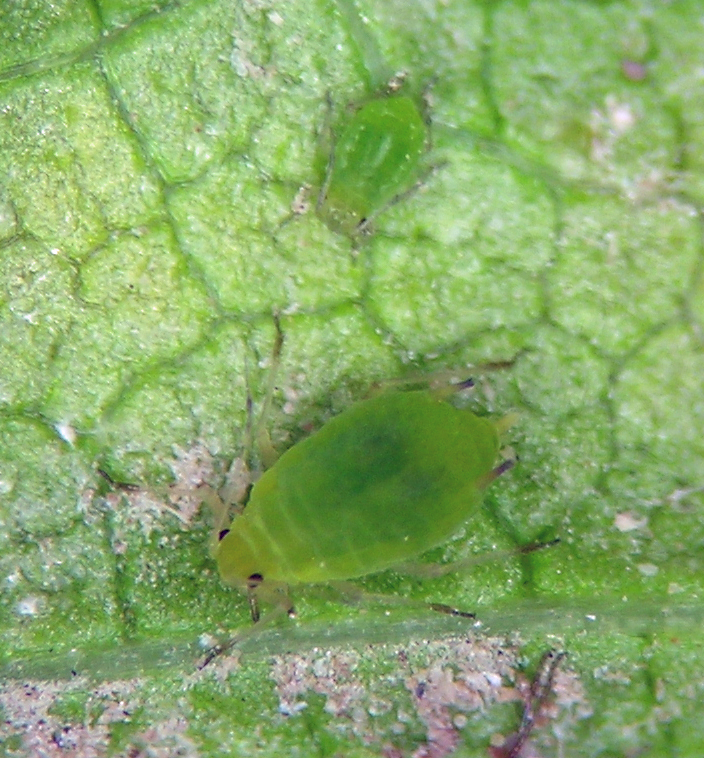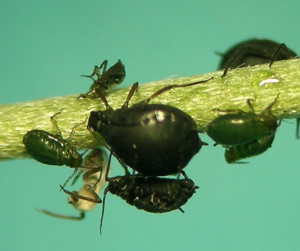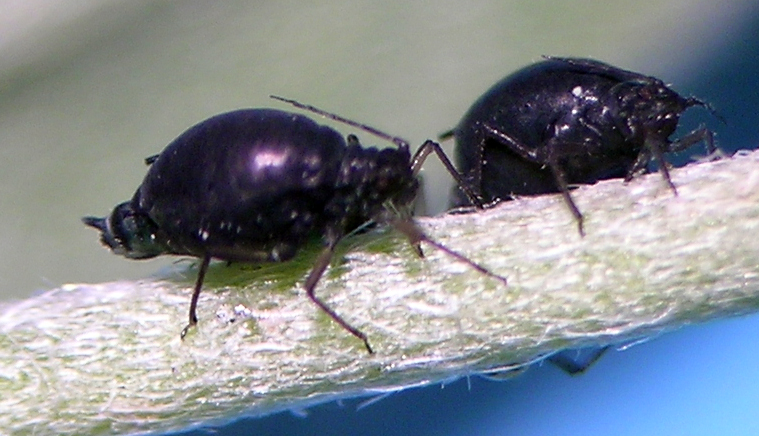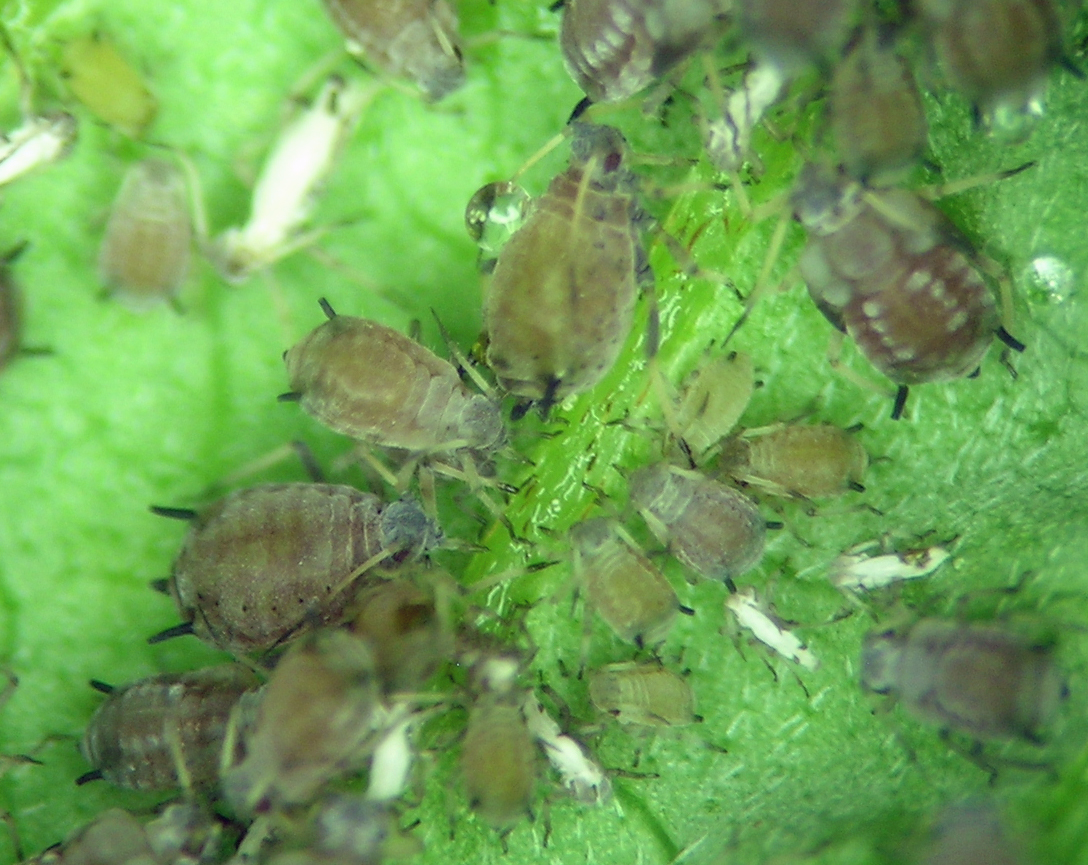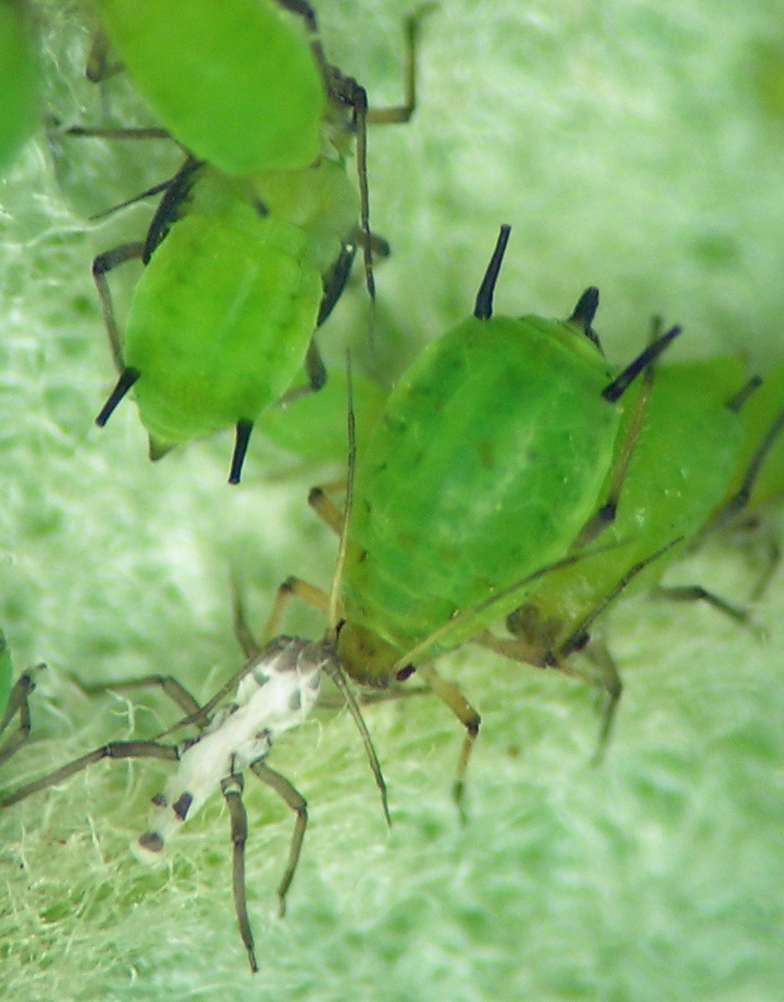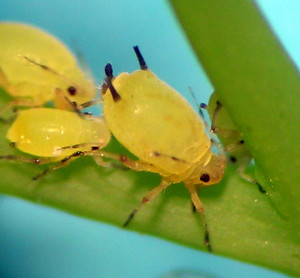Aphis Linnaeus
This page updated: December 2024.
This is the most speciose genus of aphids, with over 500. That is about 10% of all aphid species. It seems to me to speciate readily in association with host plant species or genera. My feeling is that there are many species yet to be discovered and/or described, but also that there are many synonymies yet to be discovered and documented. Some of the latter will undoubtedly be host-alternation biologies that have yet to be elucidated. I have two probably undescribed species of black Aphis from interior parts of Oregon and neighboring states on Veratrum (Liliaceae) and Hackelia (Boraginaceae). I also have a very cool species that feeds on Potentilla gracilis but looks a lot like members of Aphis (Zyxaphis).
I also have a beautiful species from several Umbelliferae (including Sphenosciadium capitellatum, Perideridia, and Lomatium) in southern Oregon, which for years evaded good photos due to its habit of getting up and running as soon as its plant is disturbed; a good photo was finally achieved in 2020. Interestingly, what appears to be the same species lives on the large lower leaves of Helianthus in western Colorado. Although this species keys out to A. asclepiadis (see below for information and photos), it is distinctive in terms of color in life, behavior, and a few taxonomic features when cleared and mounted on slides. So, the questions become, Are all the samples I’d previously identified as A. asclepiadis correctly identified, and this is a separate species? Or, is this actually A. asclepiadis and all my other samples are something else? Or, are both part of a single extremely variable species? In 2021-22 I had eggs of this species overwintering in a mesh bag on Cornus in our yard. In spring this bag was empty, but an inflorescence above it had this aphid on it. Given the apparent habit of new-born fundatrices of many aphid species to wander their plants for the best feeding sites, it’s likely that this population on the inflorescence arose from my mesh bag. Anyhow, the aphids were obviously of this color form and were morphologically recognizable from what I typically call A. asclepiadis.
Here in early 2024 I was tempted to pontificate about the lumping and splitting that are going on simultaneously in aphid classification. But, after sitting here with fingers poised over keyboard for an hour, I decided to hold off and attempt a separate essay on the subject later. I’m sure there will be thousands of you checking back here in anticipation!
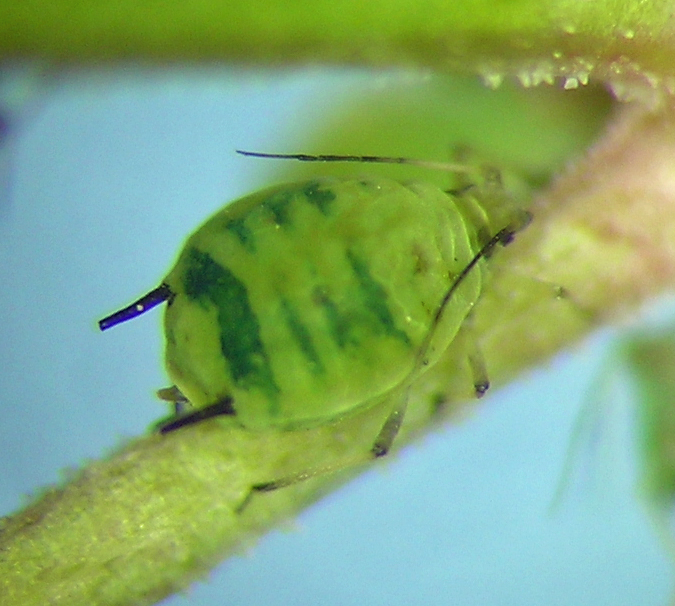
Species covered below (click on the name to jump to that species):
- Aphis agastachyos Hille Ris Lambers
- Aphis asclepiadis Fitch
- Aphis cercocarpi Gillette and Palmer
- Aphis craccivora Koch
- Aphis fabae Scopoli
- Aphis farinosa Gmelin
- Aphis gossypii Glover
- Aphis gregalis Knowlton
- Aphis lugentis group
- Aphis lupini Gillette & Palmer
- Aphis neogillettei Palmer
- Aphis pentstemonicola Gillette & Palmer
- Aphis phaceliae Gillette & Palmer
- Aphis pomi De Geer
- Aphis rubifolii (Thomas)
- Aphis spiraecola Patch
Aphis agastachyos Hille Ris Lambers
Arguably, this species may belong in the subgenus Bursaphis — it looks like a Bursaphis, and shares the unusual feature of several accessory setae on the ultimate rostral segment. But, I follow the current practice and list as Aphis sensu stricto. This species lives on the mint genus Agastache, with an abbreviated life cycle ending in June or July. I have also collected a similar species, from Monardella odoratissima, another mint species that interestingly smells almost identical to Agastache urticifolia. The aphid on Monardella has typical coloration of Bursaphis in western U.S., pale mottled green, as opposed to the dark green of A (B.) agastachyos.
I have material of A (B.) agastachyos from Washington, Oregon, and Idaho.
Aphis asclepiadis Fitch (formerly Aphis carduella Walsh (formerly Aphis helianthi Monell))
This is a species that cannot be missed when collecting in the inland Pacific Northwest, especially the mountains connected to the Rockies and the Sierras.
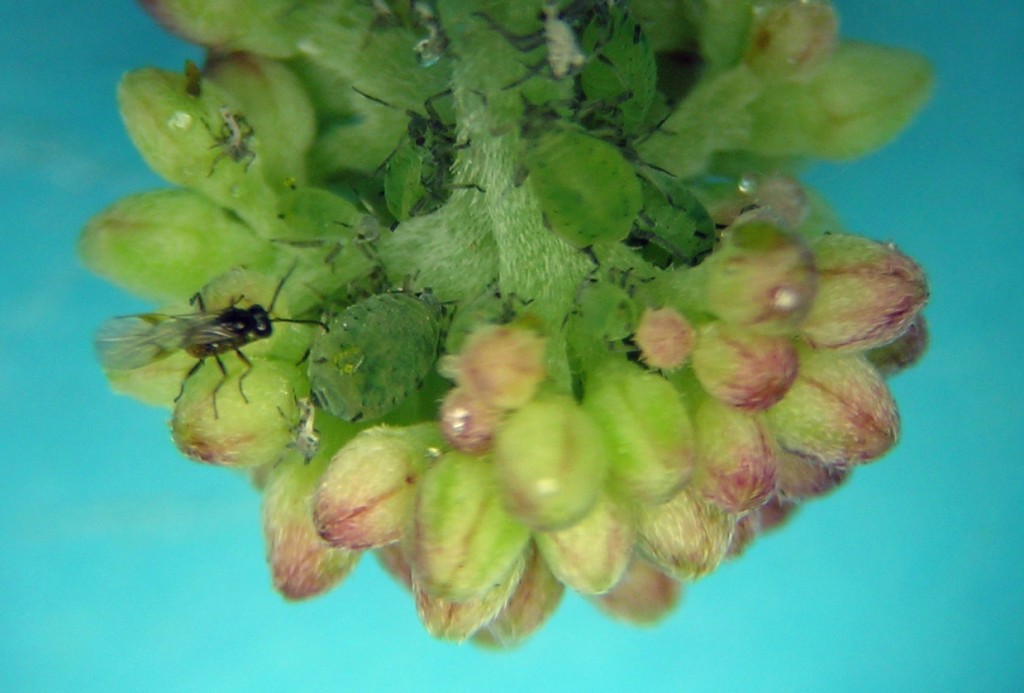
It overwinters on Cornus stolonifera, then migrates to many secondary hosts throughout summer. In the mountains I frequent, this species is analogous to Macrosiphum euphorbiae in that it colonizes many hosts, and a majority of samples of Aphis from high mountain sites and in and near the northern Rocky Mountains seem to be this species. Have a look at my collection database for more details on hosts. See some other notes above about the taxonomy of this species in western U.S.A. As alluded to there, I think the current synonymy of this ‘species’ is incorrect and needs to re-evaluated, especially with samples from Pacific Coast states and British Columbia.

Aphis cercocarpi Gillette and Palmer
After many years of study and recent evaluation of type specimens, I published my work on this aphid in 2021. Two Aphis names (A. coweni and A. holodisci) were declared synonyms of Aphis cercocarpi and the heteroecious life cycle and correct host plants were discussed. It’s one of the peculiarities of taxonomy and rules of zoological nomenclature that now there is an aphid named after the plant genus Cercocarpus that doesn’t live on that host.
In that 2021 paper I wrote, “Aphis cercocarpi has a complex life cycle biology. As noted above, it is heteroecious with Holodiscus as primary hosts and Veratrum as secondary hosts. Having recently learned species–level taxonomy of Veratrum, I now know that most samples were collected on Veratrum californicum Durand, but it is possible that other Veratrum species are also colonized. Under some circumstances, however, this aphid remains on Holodiscus throughout the growing season, reproducing on partially curled leaves at the tips of branches. Such full–season presence on Holodiscus almost always occurs at high elevations on Holodiscus growing in rocky mountain tops, steep rocky slopes, and talus. Complicating the picture is that in some high–elevation short–season locations this species produces apterous males. While some experts may lean toward the idea that there are two species involved, one monoecious with apterous males and the other heteroecious with alate males, favored here is the idea of a single species that pursues two different life cycle strategies. This would be a reasonable approach for an aphid that lives in harsh, short–season habitats. For example, Holodiscus on rocky mountain tops frequented by A. cercocarpi has an exceptionally short growing season, with flowering in mid–July and complete leaf drop by mid–September. These localities are also subject to extreme drought in some years, leading to early leaf drop and dormancy, and extreme snow cover well into summer in other years. It is reasonable to hypothesize a bet–hedging life cycle strategy of partial heteroecy, allowing a normal host alternation in good years, and providing for successful survival of the full life cycle on Holodiscus in bad years or difficult locations. I cannot eliminate the possibility that two species are involved, but until much more evidence is gathered, it is best to consider all this life cycle variation to be a complex strategy of a single species.
Alatae can be found colonizing Veratrum from early spring, not long after plant emergence, until mid–summer. As alluded to above, “spring” in some parts of this aphid’s range may begin in July due to cool conditions at high elevations. Alatae have an uncanny ability to locate each other on young Veratrum plants, early spring colonies almost always consisting of two or more alate immigrants and their offspring. Aphis cercocarpi on Veratrum are usually tended by ants, and early spring colonies can often be detected most easily by watching for aggressive ants. Later in the season this aphid develops large populations on Veratrum leaves, often covering both upper and lower surfaces in a characteristically dispersed manner (Fig. 19). Sometimes, however, A. cercocarpi can be found among the flowers and fruits of Veratrum, where it tends to be larger and to have more dorsal abdominal pigmentation. When found on stems or inflorescences, A. cercocarpi sometimes occurs in mixed assemblages with the other Aphis species I have studied on Veratrum (for discussion, see below). In autumn A. cercocarpi alatae and alate males migrate from Veratrum to Holodiscus and can be easily seen on the leaves. Offspring of these migrating alatae develop into oviparae as is typical of heteroecious aphids.
As mentioned above, I strongly suspect that all early primary host samples of this species were actually taken from Holodiscus that was mis–identified as Cercocarpus. The possibility that A. cercocarpi can feed on Cercocarpus despite my inability to find it on that host over the years cannot, however, be ruled out. The known distribution of A. cercocarpi in the USA effectively matches that of its Holodiscus hosts, including samples from Washington, Oregon, California, Nevada, Idaho, Montana, Colorado, and New Mexico; it almost certainly also occurs in Arizona, Utah, and Wyoming.”
Aphis craccivora Koch
This is a common pest aphid, now distributed throughout most of the world. It is known as a crop pest in many places, particularly the tropics and subtropics, but in the north temperate areas I frequent, it is most common on invasive weeds. If you’ve watched old cowboy movies, you’ve probably seen one of Aphis craccivora‘s most common hosts in our areas: tumble weed (also known as Russian thistle, Kali tragus). Most years in the fall, this aphid’s populations explode on Kali tragus as the plant matures. During 2020 I heard of very damaging populations of this aphid on alfalfa in spring, something I gather has been seen elsewhere but rarely or never in the Northwestern U.S. In fact, I even had a big colony on a volunteer alfalfa in our yard. Aphis craccivora is normally evident only in late summer, so these finds on alfalfa in spring suggest something new is happening in our region.
Aphis fabae Scopoli
This aphid, also known as black bean aphid, is one of those pest species that is now distributed nearly worldwide. Although it has “bean” in its name, I very rarely see it on legumes of any kind.
The A. fabae in western North America seem to fit the categories (subspecies) discussed by Blackman and Eastop that colonize Asteraceae and various other plants. That said, I am skeptical that subspecies defined reasonably well through host plant biology and slight morphological differences in Europe will be particularly meaningful in North America. As a consequence, I file everything in the A. fabae group in one box in my collection.
This is an introduced species that has managed to slot into native plant systems in North America, such as commonly overwintering on native Viburnum and Philadelphus species, and turning up (apparently, if my taxonomy is trustworthy) on things like Valeriana and Veratrum in the mountains. However, the most common habitats for it in my area are still cropping systems and landscapes.
Aphis farinosa Gmelin
A very interesting species, A. farinosa occurs across the entire northern hemisphere in temperate areas, feeding without host alternation on many species of Salix (willow) (it also occurs in Argentina, according to Blackman and Eastop). The biogeography of animals like this intrigues me: native or introduced? How long has it been so widely distributed? And so on.
I have some affection for this species because of its audacious-long siphunculi and its colorful colonies full of oviparae and males by early summer. My material is from Washington, Oregon, California, Idaho, British Columbia, Quebec, and Germany.
Aphis gossypii Glover
This is another pest aphid of almost cosmopolitan distribution, for which I have little affection, also known as cotton aphid and melon aphid.
In the northern temperate areas I collect, it is relatively uncommon, thank goodness, being far more common and polyphagous in the subtropics and tropics. As you can read in Blackman and Eastop and elsewhere, this species is terribly variable and complicated taxonomically. Although some want to split it into several species, my relative isolation from major collections and biological study of the species in the field both lead me to lump specimens in my collection.
As you can see from just the photos presented here, A. gossypii varies a lot in color and appearance. I have seen it almost white, and so tiny that adults were far under 1 mm in length. Walk through a place like Orlando, Florida or San Antonio, Texas, and A. gossypii is likely to be the main aphid living on ornamentals, including the smallest herbs to fully expanded leaves of trees. During my postdoc years at the USNM, identification of aphids intercepted at ports of entry was generally a long string of A. gossypii and Myzus persicae, occasionally punctuated with something else.
In our Idaho garden, it seemed to appear only late in the summer and fall, colonizing several different plants, apparently flying in from elsewhere. In our Colorado gardens I’ve seen it a few times, apparently having been brought in on ornamentals purchased from garden stores.
Aphis gregalis Knowlton (or is it Aphis ornata (Gillette & Palmer)?)
Here is a really beautiful aphid that I had somehow never seen before. In a few Oregon sites in 2020 it was extremely common on green rabbitbrush, causing an apical leaf curl and tended by aggressive ants. Later in the season, I could not find it anywhere. Subsequent evaluation of my undetermined Aphis and Protaphis samples revealed additional specimens from various places in Oregon, Washington, New Mexico, and Nevada. Among these were one slide of oviparae and apterous males. The oviparae have moderately swollen hind tibiae with scattered scent plaques.
As noted under my discussion of Protaphis, my firm position is that this species belongs with the North American species of Protaphis if we are to accept it as a separate genus. In fact, A. gregalis is very similar morphologically to Protaphis tetradymia. I will not make this genus change here on AphidTrek because I promised years ago not to engage in such shenanigans.
I have material from Washington, Oregon, Nevada, and New Mexico.
Aphis lugentis group
For many years I have been collecting Aphis from Senecio and filing them in a box labeled “Aphis lugentis and others on Senecio.” One reason for this is the extremely wide range of habitats and Senecio species involved. I get this group of Aphis in the highest mountains to the harshest deserts and steppe, to the wettest streamsides, swamps, etc. It seemed unlikely to me that all these samples could represent a single species. During December of 2022 I finally sorted this material, about 60 slides total. The results? I have four easily separated putative species in this box. One, which of course may be A. lugentis (but may not be), comprises about 40 of these slides. It is from all over the western U.S. and from quite a range of habitats. Another species (6 slides) with oddly thin antennal segments is so far from riparian Senecio in eastern Oregon and Idaho. The third one (6 slides) is so far from mountain slopes in eastern Oregon and Idaho. The fourth one (only one slide, alas) was from a shrubby Senecio(?) in the hills above Albuquerque, New Mexico. In 2024 I found another oddity in this species group on a Packera or Senecio species in western Wyoming that completely lacks lateral tubercles (this is also apparently in the British Museum, based on Blackman and Eastop’s website). Based on my samples, it might be relatively simple for an energetic person to borrow samples from around the continent, collect some more, and publish the details of this species group for North America.
Aphis lupini Gillette & Palmer
One phenomenon I’ve observed over the years is that some Aphis species seem to come and go; some years a given species will seem to be everywhere its host grows, then for years afterward it seems to be incredibly rare. That is the case with A. lupini. I have only seen it a few times in all the years I’ve looked at Lupinus in the west, yet in a couple years it has been very common. In fact, in one year I found a population of what appeared to be this species that was bright orange like Aphis nerii. As noted in the photo, this is a species with wingless (apterous) males. I have one sample, from the hills above Lake Abert in southern Oregon, that may be a different species. It is distinct from my other A. lupini by having reduced dorsal setation, e.g. only 2-4 setae on abdominal tergite VIII instead of the usual 8-10 (-ish). These specimens otherwise look like A. lupini, including the distinctive pointed cauda and large lateral tubercles.
I now have material from Washington, Oregon, and Utah.
Aphis neogillettei Palmer
With about 10% of all aphids in the genus Aphis, that’s a lot. This is yet another species that is fairly easy to recognize if you know the host (Cornus stolonifera) and the broad geography. It seems to live throughout the season on this plant. It occurs widely in North America and I have collected it in Oregon, Idaho, Montana, and Wisconsin.
Aphis pentstemonicola Gillette & Palmer
This species I have collected here and there for a long time, and sometimes confusing it with Aphis asclepiadis (a.k.a. the Aphis helianthi group), which also feeds on Penstemon in the mountains of western North America. This is one of many aphids that is most recognizable in life because of a color pattern that is entirely in the internal tissues that dissolve in the slide-mounting process. In the photo here, the distinctive dark blotch in the anterior abdomen is unusual and diagnostic.
I have material from Washington, Oregon, California, Idaho, Utah, Nevada, Wyoming, and Colorado.
Aphis phaceliae Gillette & Palmer
For many years this aphid was an exciting find, because although I looked at lots of Phacelia, this species of aphid was rarely found. During the 2016 season I found that it can reasonably consistently be found in southeastern Oregon on Phacelia in the spring growing in dry disturbed soil such as south-facing road-cuts, recent timber harvest, etc. Since then I continue to find it in similar disturbed sites across the west. It is monoecious and I suspect it has an abbreviated life cycle, but have not been able to demonstrate the latter.
I have material from Washington, Oregon, Idaho, Wyoming, and Colorado.
Aphis pomi De Geer
This is the common pest on cultivated apples in my region and around much of the world, and several years ago I was finally able to get some decent photos of it on my backyard trees. Interestingly, ants were tending the aphids and successfully maintained massive numbers of aphids on the trees all summer.
I tell anyone who will listen to be careful when identifying Aphis species from cultivated apple – the temptation is to assume that aphids with this general appearance are all Aphis pomi but care must be observed that A. pomi and Aphis spiraecola (see below) are not mixed up.
Aphis rubifolii (Thomas)
This is a fairly common species on blackberries, genus Rubus, in western North America where we lurk. The trick to finding it is that it can be very small indeed, with adult apterae commonly less than 1 mm long. I say it’s common, yet I have only 3 samples in my collection (from Washington, California, and Maine). The reason is likely that I often pass by common species without collecting them. I am trying to break this habit at least to some degree.
Aphis spiraecola Patch
Travel almost anywhere in temperate, subtropical, and tropical Earth and this species is there.
I usually carry a couple vials when traveling to Florida, Arizona, or Texas for work-related trips in winter. When really desperate to make a winter aphid collection, I can almost always find this species in these southern states. In the Northwest it can be incredibly abundant on ornamental Spiraea and is sometimes one of the most commonly trapped aphids in agricultural areas. It lived throughout the season in our Idaho garden on various ornamental Rosaceae. It can be a nice apple-green to bright yellow.

